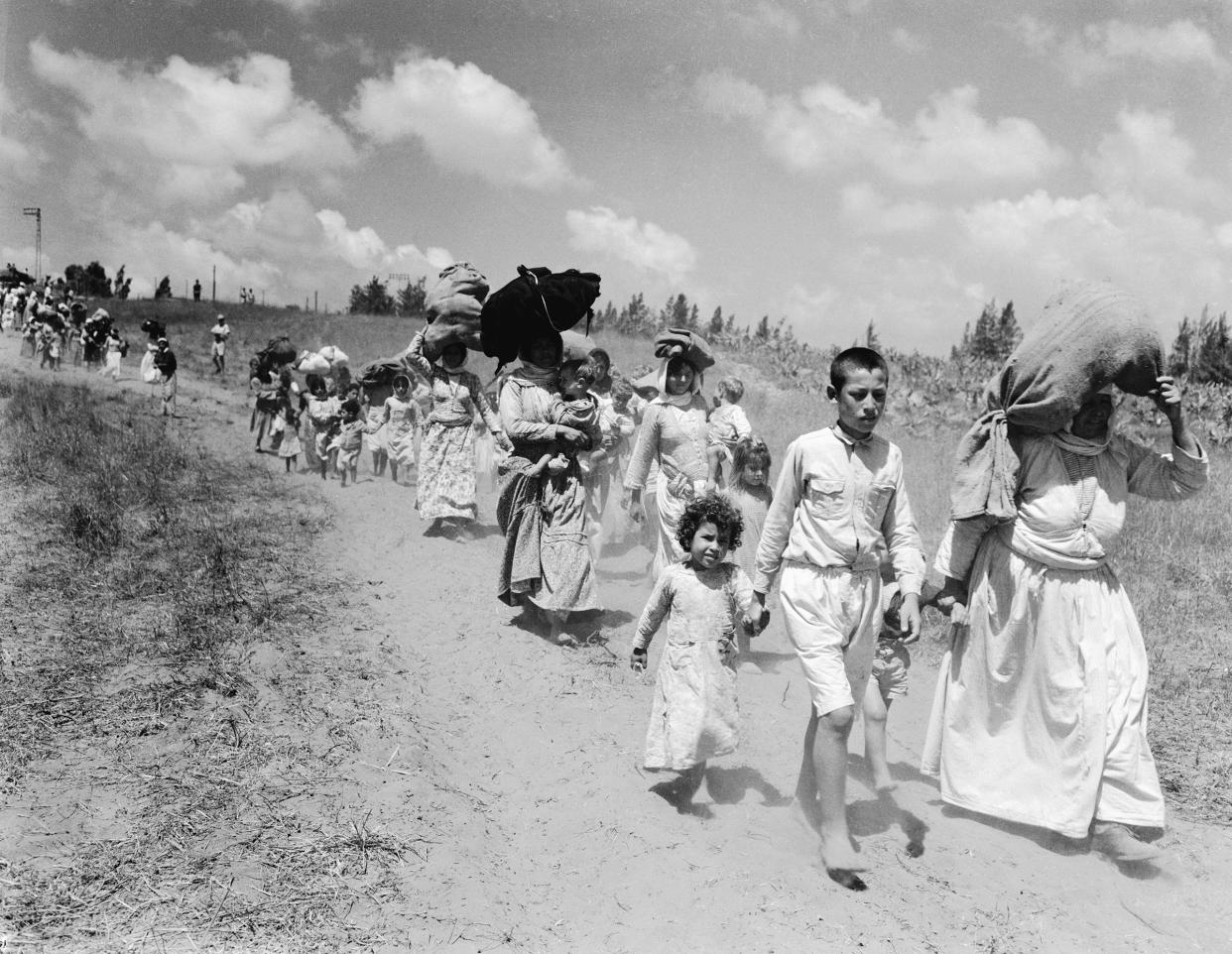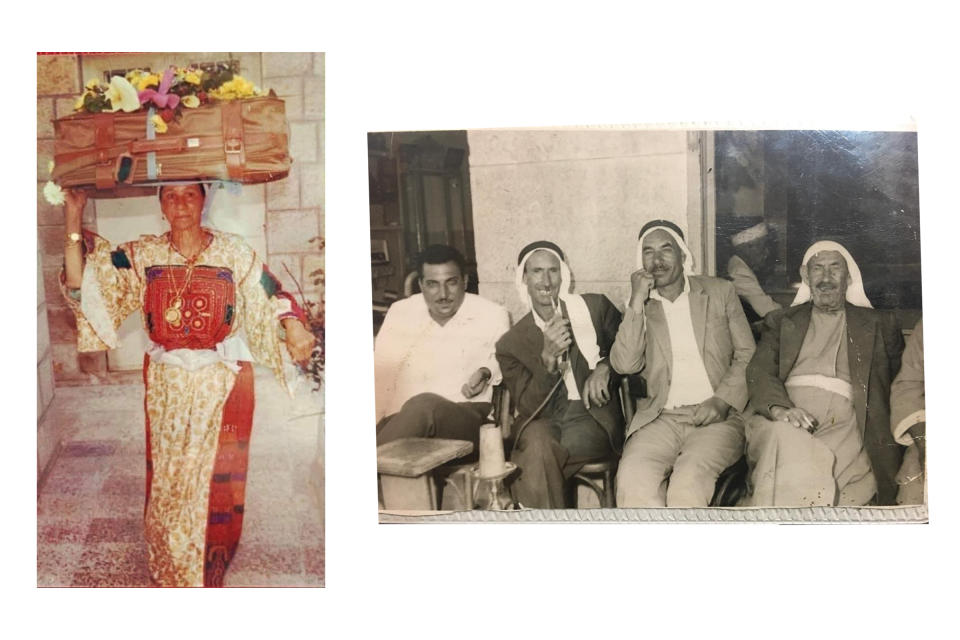The Solemn History Behind Nakba Day

Arab refugees, mostly women and children, from a village near Haifa begin a three mile hike carrying large bundles of personal possessions to the Arab lines in Tulkarim, West Bank, on June 26, 1948. Credit - Bettmann Archive/Getty Images
Every year on May 15, Palestinian people across the world observe what is known as Nakba Day, the solemn anniversary of the day in 1948 when the Arab-Israeli War began, precipitating a wave of displacement and expulsion among the Palestinian population. This year, with more than 450,000 people—nearly a quarter of Gaza’s population—newly displaced in just the past week, the commemoration of the Nakba, Arabic for “catastrophe,” takes on new significance.
For those who observe it, Nakba Day is not only a day for mourning, but for a sense of re-establishment. Although it is annually remembered, the event has historical nuances and driving forces that can contribute to an understanding of the current events in Gaza.
What is commemorated on Nakba Day?
Political Zionism—the movement to create a Jewish state—dates back to the 19th century, but the persecution of Jewish people in Europe in the 1930s and the horrors of the Holocaust helped drive a massive migration in that decade of 60,000 Jews to what was then known as Mandatory Palestine, the British-controlled land that was majority Muslim-Palestinian at the time. In the midst of increasing conflict over the land, the United Nations proposed a division of Arab and Jewish states; the proposal was opposed by the Arab population of the land, and a civil war followed the announcement of the plan. When Israel declared its independence on May 14, 1948, following Britain’s departure, armies from several neighboring Arab lands joined the war on the side of the Palestinian Arab population. Their invasion took place on May 15.
Read More: Why the Director of Netflix’s Farha Depicted the Murder of a Palestinian Family
In the years prior to and during the war that followed, as Israel pushed back the forces of its neighbors, over half the Palestinian population was displaced. From 1947 to 1949, 531 towns were destroyed by Israeli militias, according to the West Bank-based Palestinian Central Bureau of Statistics, homes were shelled, and 15,000 people were killed, including women and children. “They witnessed rapes, imprisonment of men and boys, and almost all of them witnessed the destruction of major cultural sites,” says professor Abdel Razzaq Takriti, who teaches modern Palestinian and Arabic History at Rice University. (By the end of the Arab-Israeli war, over 6,000 Israelis lost their lives, including some in mass killings.)
“There were attacks on water sources; Akka [also known as Acre], for example, was subjected to biological warfare. Their water was poisoned to try to force the populations out,” Takriti says. “The idea was to have as much land appropriated with the fewest Palestinian population remaining as possible.” Further attempts to poison water supplies in Gaza were thwarted when Egyptian officials found out, says Takriti.
Of the 1.4 million-strong Palestinian population at the time, 800,000 were displaced; the massacres of families and towns left enduring scars on the survivors. “The Nakba has two dimensions,” Takriti says. “The humanitarian catastrophe entails loss of land, loss of property and expulsion of the people. The other dimension was the political catastrophe, which entailed suppression of native sovereignty. Those two aspects of reality continue to this very day”
Razan Ghabin, a 26-year-old Palestinian living in the U.S., recounts the stories told to her by her grandparents who survived the Nakba. Ghabin’s grandmother, Othmana As'ad Ghabin, was a Palestinian refugee from Lifta, a village on the outskirts of Jerusalem. Born in 1925, Othmana recounted the Nakba to her granddaughter many times. She would test her children and grandchildren by having them repeating her memories back to her to ensure that her stories never died. The Liftawi people were affluent, with many of the relatives in the families holding Master’s degrees. Lifta is now known as “Palestinian Pompeii”–the original buildings left behind after the Nakba still stand today, deserted.

Israeli militia attacked a coffee shop in the village in 1948 while Othmana’s family were there, she says. The military threatened them and told them to leave, telling them it would be temporary. They hid in a nearby cave and any time they tried to return they’d be shot at. They later had to establish a life as refugees in Ramallah, a city in the West Bank. Even though the borders opened years later in 1967, As’ad was never able to return to Lifta. The family continues to live in Ramallah.
How is Nakba Day commemorated today?
Yousef Kassim, a Palestinian-American and son of Nakba survivors, emphasized the importance of the day for Palestinians worldwide. “We certainly reflect on it as a family; we’ll share stories or my dad will share stories. He was a baby when it actually happened, but less and less people that were alive when it happened are still here. For a lot of them it’s tough to talk about,” Kassim says. “We believe it’s still ongoing, because so long as the Palestinians that were expelled and their descendants aren't allowed to return, it’s ongoing for them.”
Read More: Imagining a Free Palestine
“My father was from Lifta, next to Deir Yassin”—the site of one of the most infamous massacres of the Nakba—“and that’s where my paternal grandmother was born,” he says. “News spread quick to the neighboring villages, news of the murders and rapes.” Village residents were not in a position to fend off the gangs. Kassim’s grandfather rented houses to Holocaust survivors and Jewish immigrants, and after what happened to his family, was left penniless with 12 kids. Yousef Kassim’s family lived only six miles outside of Lifta but was never allowed to return. “He lived until he was 93 years old and never got to see justice.”
Palestinian right of return groups and committees across the world demand rights during this day, recounting the destruction of their individual towns and cities, says Takriti. “The refugees want a repatriation, and vehemently reject the resettlement and want their land back. They also want an end to the military occupation and Israeli apartheid systems.” Many Palestinians demand political, national, and humanitarian respect during this time, and they do this through marches, rallies, speeches, publications and cultural activities.
“A lot of Palestinians, when we think of the Nakba we think of really horrible events,” Kassim says, “but we also gain a lot of inspiration from the way that our parents and grandparents approached really difficult situations with a lot of grace.”
Correction, May 16: The original version of this article misstated the period during which over half the Palestinian population was displaced; it covers the time prior to May 15, 1948, not just from that day until the end of the war. It also mischaracterized the Israelis in Kassim's relative's account of the Nakba; he was told they were gangs, not military forces.
Contact us at letters@time.com.

